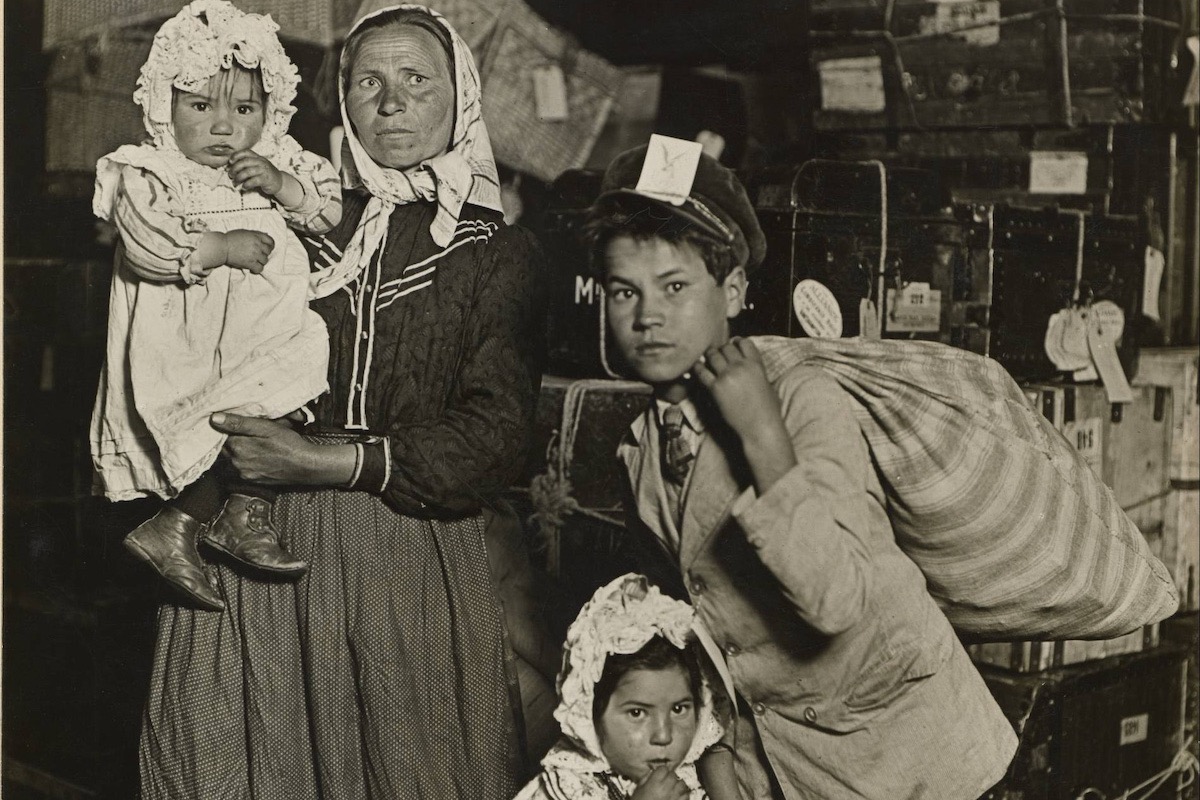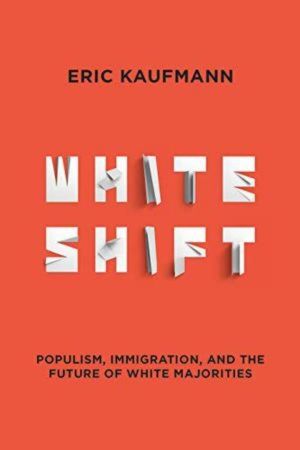recent
How Can We Manage the Process of Western ‘Whiteshift’?
Ethno-traditional nationalists favour slower immigration in order to permit enough immigrants to voluntarily assimilate into the ethnic majority, maintaining the white ethno-tradition.

We need to talk about white identity. Not as a fabrication designed to maintain power, but as a set of myths and symbols to which people are attached: an ethnic identity like any other.
In the West, even without immigration, we’re becoming mixed-race. This is not speculation, but is virtually guaranteed by the rates of intermarriage occurring in many Western countries. Projections reveal that faster immigration may slow the process by bringing in racially unmixed individuals, but in a century those of mixed-race will be the largest group in countries such as Britain and the United States. In two centuries, few people living in urban areas of the West will have an unmixed racial background. Most who do will be immigrants or members of anti-modern religious groups such as ultra-Orthodox Jews. The reflex is to think of this futuristically, as bringing forth increased diversity, or the advent of a “new man.” But, if history is our guide, things are likely to turn out quite differently. Many people desire roots, value tradition and wish to maintain continuity with ancestors who have occupied a historic territory.
This means we’re more likely to experience what I term “whiteshift,” a process by which white majorities absorb an admixture of different peoples through intermarriage, but remain oriented around existing myths of descent, symbols and traditions. Naturally there will be contestation, with cosmopolitans lauding exotic origins; but most people will probably airbrush their polyglot lineage out of the story to focus on their European provenance.
We see this process of selective forgetting and remembering time and time again among ethnic groups in history. In Turkey, for example, many groups represented in the ethnic majority’s DNA have been forgotten. Most Turks trace their origins to Central Asia, neglecting their Byzantine Christian ancestors and the large number of immigrants who arrived from far-flung parts of the Ottoman Empire.

Whiteshift has a second, more immediate, connotation: the declining white share of the population in Western countries. Whites are already a minority in most major cities of North America. Together with New Zealand, North America is projected to be “majority minority” by 2050, with Western Europe and Australia following suit later in the century. This shift is replacing the self-confidence of white majorities with an existential insecurity channelled by the lightning rod of immigration. No one who has honestly analysed survey data on individuals—the gold standard for public opinion research—can deny that white majority concern over immigration is the main cause of the rise of the populist right in the West. This is primarily explained by concern over identity, not economic threat. I explore this data in considerable detail in the first part of my new book (from which this essay is adapted). Not everyone seeks to maintain connections to ancestors, homeland and tradition, but many voters do.
The loss of white ethno-cultural confidence manifests itself in other ways. Among the most important is a growing unwillingness to indulge the anti-white ideology of the cultural left. When whites were an over-whelming majority, empirically unsupported generalizations about whites could be brushed off as amusing and mischievous but ultimately harmless. As whites decline, fewer are willing to abide such attacks. At the same time, white decline emboldens the cultural left, with its dream of radical social transformation. The last time this blend of ethnic change and cultural contestation occurred, in fin-de-siècle America, the anti-WASP adversary culture was confined to a small circle of bohemian intellectuals. Today, the anti-majority adversary culture operates on a much larger scale, permeates major institutions and is transmitted to conservatives through social and right-wing media. This produces a growing culture-war polarization between increasingly insecure white conservatives and energized white liberals.
The Western tradition of opposing one’s own culture begins with the so-called “lyrical left” in the late 19th century, which lampooned bourgeois values. After the First World War, the cultural left turned against the nation, to the point that by 1930, according to the liberal George Orwell, “in left-wing circles, it is always felt that there is something slightly disgraceful in being an Englishman.” In the more diverse United States, the lyrical left’s critique took the form of an attack on their own ethnic group, the Anglo-Protestant majority, whom they saw as oppressing European immigrants and enforcing puritanical laws such as the prohibition on selling alcohol. In the 1960s, this countercultural movement, which I term left-modernism, developed a theory of white ethno-racial oppression. Its outlook superseded the logical, empirically grounded, left-liberal Civil Rights Movement after 1965 to become a millenarian project sustained by the image of a retrograde white “other.” Today, left-modernism’s most zealous exponents are those seeking to consecrate the university campus as a sacred space devoted to the mission of replacing “whiteness” with diversity.
It’s important to have people criticizing their own group: What Daniel Bell termed the “adversary culture” spurs reform and creativity when it collides with the majority tradition. But what happens when the critics become dominant? In softer form, left-modernist ideology penetrated widely within the high culture and political institutions of Western society after the 1960s. This produced norms that prevented democratic discussion of questions of national identity and immigration. The deviantization of these issues in the name of anti-racism introduced a blockage in the democratic process, preventing the normal adjustment of political supply to political demand. Instead of reasonable trade-offs between those who, for example, wanted higher or lower levels of immigration, the subject was forced underground, building up pressure from those whose grievances were ignored by the main parties. This created a market opportunity which populist right entrepreneurs rushed in to fill.
Ethno-cultural change is occurring at a rapid rate at precisely the time the dominant ideology celebrates a multicultural vision of ever-increasing diversity. To hanker after homogeneity and stability is perceived as narrow-minded and racist by liberals. Yet diversity falls flat for many because we’re not all wired the same way. Right-wing populism, which champions the cultural interests of group-oriented whites, has halted and reversed the multicultural consensus which held sway between the 1960s and late 1990s. This is leading to a polarization between those who accept, and those who reject, the ideology of diversity. What’s needed is a new vision that gives conservative members of white majorities hope for their group’s future while permitting cosmopolitans the freedom to celebrate diversity.
Cosmopolitanism and what I term ethno-traditional nationalism are both valid worldviews, but each suits a different psychological type. Imposing either on the entire population is a recipe for discontent because value orientations stem from heredity and early life experiences. Attempts to re-educate conservative and order-seeking people into cosmopolitanism will, as the psychologist Karen Stenner notes, only generate resistance. Differences need to be respected. Whiteshift—the title of my book, as well as the word I use to describe my approach to the subject—isn’t just a prediction of how white identity will adapt to demographic change, but a positive vision that can draw the sting of right-wing populism and begin to bridge the “nationalist–globalist” divide that is upending Western politics.
We are entering a period of cultural instability in the West attendant on our passage between two relatively stable equilibria. The first equilibrium was based on white ethnic homogeneity, the second on what the prescient centrist writer Michael Lind calls “beige” ethnicity, i.e. a racially mixed majority group. In the middle lies a turbulent multicultural interregnum. We in the West are becoming less like homogeneous Iceland and more like homogeneous mixed-race Turkmenistan. But to get there, we’ll be passing through a phase where we’ll move closer to multicultural Guyana or Mauritius. The challenge is to enable conservative whites to see a future for themselves in whiteshift—the mixture of many non-whites into the white group through voluntary assimilation. (Unmixed whiteness is not about to disappear and may return in the long run, but this is getting ahead of the story, so I hope you’ll read on.)
* * *
Right-wing populism in the West is different from its Eastern European variant for two main reasons. First, it is not about recovering from national humiliation or pining for a better time before democracy arrived when a strong leader gave society a clear direction. These were important motivations for inter-war fascists like the Nazis, Mussolini, Franco or the Hungarian Arrow Cross, and remain important in Russia, Greece and a number of Eastern European states. Second, immigration is less important outside the West because migrants tend to avoid or pass through Eastern European states. It’s a factor in some ex-Communist nations (if inside the EU), such as Hungary, which are not used to it, but the issue often ranks lower on voters’ priority lists. Many of the forces that matter in the East count for less in the West, and vice-versa.

Anyone who wants to explain what’s happening in the West needs to answer two simple questions. First, why are right-wing populists doing better than left-wing ones? Second, why did the migration crisis boost populist-right numbers sharply while the economic crisis had no overall effect? If we stick to data, the answer is crystal clear. Demography and culture, not economic and political developments, hold the key to understanding the populist moment. Immigration is central. Ethnic change—the size and nature of the immigrant inflow and its capacity to challenge ethnic boundaries—is the story.
Indeed, if history is any guide, we shouldn’t be asking why there is a rise in right-wing populism but why it hasn’t materialized faster in places such as Sweden or the United States. The Swedish state will adapt to any ethnic configuration, but this is much trickier for the Swedish ethnic majority. While Sweden can make citizens in an afternoon, immigrants can only become ethnic Swedes through a multi-generational process of intermarriage and secularization.
Whiteshift explores two interconnected topics: white ethnic majorities and the white tradition of national identity. Put simply, ethnic groups are communities that believe they are descended from the same ancestors and differentiate themselves from others through one or more cultural markers: language, racial appearance or religion. They are also typically attached to hazily defined “homelands.” Nations are territorial-political communities with clear territorial boundaries and political aspirations, which ethnic groups need not have. Ethnic groups, like the Jews, unite around common ancestry, whereas nations—such as Switzerland—can be multi-ethnic. White majorities in the West are every bit as ethnic as minorities are, but, for many, their sense of ethnicity and nationhood is blurred. If you’re white, you may think, “I don’t identify as white, only as British.”
This arises because being white in a predominantly white society, like being heterosexual, doesn’t confer much distinctiveness. Even groups that are minorities, such as WASP Americans, may have a weaker identity because their ethnicity forms the national archetype and thus is confused with it. Likewise, those at the cultural centre lose their identity: pronouncing words in a Thames Estuary accent, like most British TV anchors, similar to sporting a flat Midwestern accent in the United States, means you won’t think you have an accent at all, even though you do. On the other hand, Britain is very different from the world’s other 195 countries, so when you’re abroad, your British nationality is unmistakeable. Nations also promote themselves more vociferously than ethnic groups. The fact that Britain is a political unit with a budget means the British nation has taken steps to inculcate identity in its citizens in a way the white British ethnic group has not. Finally, norms may discourage white identity: Expressing white British identity is frowned upon due to the expansion of the meaning of anti-racism that has taken place since the 1950s. Taken together, this means majority ethnicity is backgrounded in everyday life.
If you’re like most white Brits, your ethnicity is hidden at the centre of your national identity. It’s present in the way you imagine your nation. You notice that non-white Britons are minorities. The racial image that comes to mind when people think of a typical Briton is a white one, which won’t pose an identity issue for you because you fit it.
You’ll tend to feel an uncomplicated connection to people from Britain who lived in the country prior to 1945, 1745 or even 1245. Minorities’ sense of British national identity is less straightforward. As a thought experiment, imagine how your British identity might change if the country had been founded and inhabited by black people until the first major wave of whites arrived 65 years ago.
Because Western nations were generally formed by a dominant white ethnic group, whose myths and symbols—such as the proper name “Norway”—became the nation’s, the two concepts overlap in the minds of many. White majorities possess an “ethnic” module, an extra string to their national identity that minorities lack. Ethnic majorities thereby express their ethnic identity as nationalism. In Hazleton, Pennsylvania, where the issue of illegal immigration divided whites and Hispanics in the 2000s, whites signalled their identity with the national flag, not a special white symbol. In England, conservative working-class whites use the English flag as a badge of ethnic identity (though it loses its racial connotations during the World Cup).
When it comes to “seeing” our nation, we all wear a distinct pair of ethnic glasses. Minorities’ spectacles give them a clear sense of where their ethno-symbols end and national ones begin. White majorities don’t, because many of the national symbols they think about, like Thanksgiving in the United States or Joan of Arc in France, double as white ones. As the white share of nations declines, a thin, inclusive, values-based nationalism is promoted by governments that sidelines symbols many whites cherish, such as Christopher Columbus or Robin Hood. In addition, some minorities challenge aspects of the national narrative like empire or Western settlement. This lifts the fog for many whites, making them aware of their exclusive ethnic symbols by separating these out from those that are inclusive, like the Statue of Liberty. Combined with falling white population share, this raises the visibility of white identity, drawing it out from beneath the shadow of the nation.
Stepping back from the tide of history, we can see that ethnic majorities in the West are undergoing whiteshift, a transition from an unmixed to a mixed state. American history offers a preview of what we’re in for. We should expect a civilization-wide replay of the ethnic divisions that gripped the United States between the late 1880s and 1960s, during which time the Anglo-Protestant majority declined to less than half the total but gradually absorbed Catholic and Jewish immigrants and their children into a reconstituted white majority oriented around a WASP archetype. This was achieved as immigration slowed and intermarriage overcame ethnic boundaries, a process that still has some way to run.

Notice that identifying with the white majority is not the same as being attached to a white-Christian tradition of nationhood. Only those with at least some European ancestry can identify as members of the white majority. However, minorities may cherish the white majority as an important piece of their national identity: a tradition of nationhood. Rachid Kaci, a French centre-right secularist of Algerian-Berber origin, writes: “The Gauls…are our collective ancestors, since they inaugurated [French] history down to our days, via Clovis, Charles Martel…the Revolution, Napoleon…One who wants to be considered French adopts this history, or rather, lets himself be adopted by it.”
In the United States, some 30 percent of Latinos and Asians voted for Trump and many lament the decline of white America. In surveys taken soon after the August, 2017 Charlottesville riots, 70 percent of polled Latino and Asian Trump voters agreed that “whites are under attack in this country,” and 53 percent endorsed the idea that the country needed to “protect and preserve its white European heritage”—levels similar to white Trump voters. In fact, non-white Trump voters express a much higher level of sadness at the passing of a white majority than white Democrats. A key question for the future of American politics is whether new generations of Hispanics and Asians will move closer to, or further from, the country’s white-Christian traditions.
* * *
Is a common national “we” not the solution to all this? I’m afraid not. Political scientists often differentiate “civic nations,” defined by loyalty to the state and its ideology, from “ethnic nations” united by shared ancestry. All Western countries have been trying to promote civic conceptions of nationhood to include immigrants, but the populist right shows that limiting nationhood to “British values,” the American Creed or the French Republican tradition doesn’t address the anxieties of conservative voters. These universalist, creedal conceptions of nationhood are necessary for unity, but cannot provide deep identity in everyday life. On the other hand, ethnic nationhood, which restricts citizenship to members of the majority, is clearly a non-starter.
But things aren’t so black and white. There is a third possibility: ethno-traditional nationhood, which values the ethnic majority as an important component of the nation alongside other groups.
Ethno-traditional nationalists favour slower immigration in order to permit enough immigrants to voluntarily assimilate into the ethnic majority, maintaining the white ethno-tradition. The point is not to assimilate all diversity, but to strike a balance between vibrant minorities and an enduring white-Christian tradition. This is the view of many conservative white voters, even if there is an important (if tiny) tranche of exclusionists on the far right who dream of repatriating minorities.
As we saw with minority Trump voters, it’s important to recognize that a significant chunk of ethnic minorities are ethno-traditional nationalists because—like Welsh nationalists who don’t speak Welsh—they are attached to cultural features that make their nation distinctive. Note the difference: They are not members of the ethnic majority, but are members of the nation with an attachment to its traditional ethnic composition.
One often sees this among, say, outsiders who have moved to ethnically distinctive regions like Cajun country or Cornwall and oppose rapid erosion of the Cajun/Cornish share of the local population. At the national level, this means some ethnic minorities—especially Hispanics and Asians in America—have a vicarious attachment to the white majority and support majority ethnic aims such as reducing immigration or resisting affirmative action. As minorities increase in size, an important question for electoral politics is whether they will incline towards ethno-traditional nationalism or multiculturalism.






